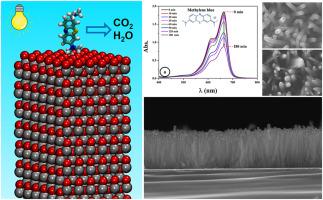Synthesis and characterization of Al-doped ZnO nanorod array as a photocatalyst under visible light irradiation
IF 4.2
3区 材料科学
Q2 MATERIALS SCIENCE, MULTIDISCIPLINARY
引用次数: 0
Abstract
Al-doped ZnO NR arrays were successfully synthesized using a low-temperature (∼90 °C) microwave-assisted hydrothermal method. The visible-light-driven photocatalytic performance of NRs was investigated as function of doping and the pH of the growth solution. Both parameters significantly influence the morphology, crystal structure, surface composition, optical and electronic properties of NRs. Particularly, Al doping led to enhanced visible light absorption, with further improvement observed in samples grown in alkaline media. The combined effect of doping and pH also induced a morphological transition from rod-like to obelisk-shaped NR nanostructures. Molecular dynamic simulation revealed that positively charged MB molecules preferentially adsorb onto the negatively charged O-terminated polar facets of ZnO NRs through electrostatic interactions. For NRs grown in neutral pH, Al doping results in enhanced photocatalytic activity, which correlates closely with the improved visible light absorption. In contrast, NRs grown in alkaline media exhibit comparable efficiencies, influenced by their optical absorption and modified morphology. Among the tested samples, AZO 1 % sample demonstrated the highest performance, achieving 52 % degradation of MB under low-intensity visible light LED illumination. The degradation reaction rate for this sample is three times higher than that of undoped ZnO NRs.

可见光下掺铝ZnO纳米棒阵列光催化剂的合成与表征
采用低温(~ 90℃)微波辅助水热法制备了al掺杂ZnO NR阵列。研究了NRs的可见光驱动光催化性能与掺杂和生长溶液pH的关系。这两个参数对核磁共振材料的形貌、晶体结构、表面组成、光学和电子性能都有显著影响。特别是,Al掺杂导致可见光吸收增强,在碱性培养基中生长的样品中观察到进一步的改善。掺杂和pH的共同作用也诱导了NR纳米结构从棒状到方尖碑状的形态转变。分子动力学模拟表明,带正电的MB分子通过静电相互作用优先吸附在带负电的ZnO NRs的o端极性面上。对于在中性pH下生长的nr, Al掺杂导致光催化活性增强,这与可见光吸收的改善密切相关。相比之下,在碱性介质中生长的nr表现出相当的效率,受其光学吸收和修饰的形态的影响。在测试样品中,AZO 1%的样品表现出最高的性能,在低强度可见光LED照明下,MB的降解率达到52%。该样品的降解速率比未掺杂的ZnO nmr高3倍。
本文章由计算机程序翻译,如有差异,请以英文原文为准。
求助全文
约1分钟内获得全文
求助全文
来源期刊

Optical Materials
工程技术-材料科学:综合
CiteScore
6.60
自引率
12.80%
发文量
1265
审稿时长
38 days
期刊介绍:
Optical Materials has an open access mirror journal Optical Materials: X, sharing the same aims and scope, editorial team, submission system and rigorous peer review.
The purpose of Optical Materials is to provide a means of communication and technology transfer between researchers who are interested in materials for potential device applications. The journal publishes original papers and review articles on the design, synthesis, characterisation and applications of optical materials.
OPTICAL MATERIALS focuses on:
• Optical Properties of Material Systems;
• The Materials Aspects of Optical Phenomena;
• The Materials Aspects of Devices and Applications.
Authors can submit separate research elements describing their data to Data in Brief and methods to Methods X.
 求助内容:
求助内容: 应助结果提醒方式:
应助结果提醒方式:


